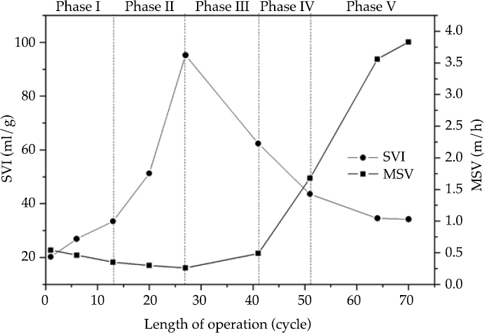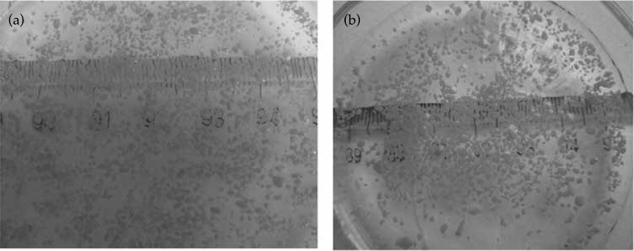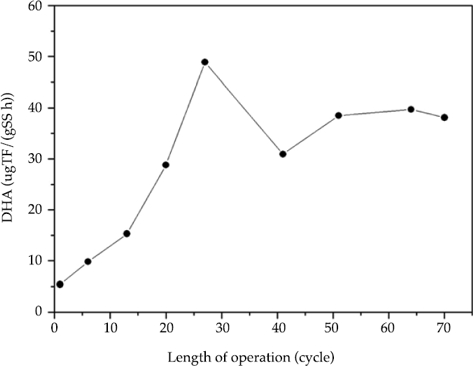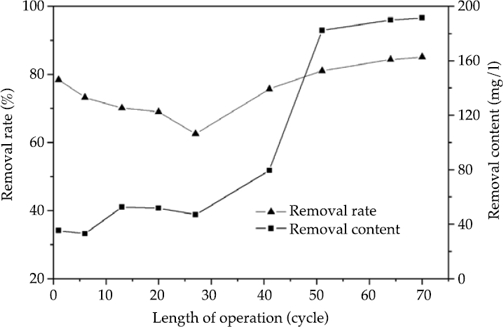Introduction
Aerobic granular sludge, a special biofilm, is spontaneously formed of self-immobilization of microorganisms (De Kreuk, Pronk, & Van Loosdrecht, 2005; Adav, Lee, Show, & Tay, 2008). It has many incomparable advantages towards common activated sludge, such as: compact structure, good settling property, big biomass, microbial metabolism diversification, high activity and high resistance to toxicity and organic loading (Adav, Lee, Show, & Tay, 2008; Morales, Figueroa, Mosquera-Corral, Campos, & Méndez, 2012; Zhao, Huang, Zhao, & Yang, 2013). Therefore, it has been widely applied to the treatment of industrial wastewater (Adav, Lee, Show, & Tay, 2008; Moussavi, Barikbin, & Mahmoudi, 2010; Taheria, Khiadani, Amina, Nikaeen, & Hassanzadeh, 2012; Rosman, Anuar, Chelliapan, Md Din, & Ujang, 2014). However, during the reactor operating, there is idle frequently in aerobic granular sludge system because of accidents or other causes, and then granules will lose activity easily during long-term idle process. Thus it has a great significance to study the storage and activity recovery of aerobic granular sludge in its engineering application. In particular, the success development of storing aerobic granular sludge can extend application of aerobic granules as inoculums for rapid startup, and as microbial supplement to enhance treatment of bioreactor systems. There are reports on the reactivation of aerobic granular sludge and results have showed that aerobic granular sludge has a good stability and resiliency after the thawed granules have to be recovered successfully, and the activity of revived sludge can even return to the level of original state (Adav, Lee, & Tay, 2007; Lee, Chen, Show, Whiteley, & Tay, 2010; Gao, Yuan, & Liang, 2012; Lv et al., 2013). However, to the authors’ knowledge, there are no reports concerning the reactivation of aerobic granules after thawing under high salt stress.
In order to solve the problem mentioned above, high salt aerobic granules, which were cultivated successfully in laboratory scale column-type sequencing batch reactor (SBR) operating with synthesis saline wastewater (the NaCl content of 3%, calculated as weight to volume) in previous study, was took out to be washed by distilled water several times to remove the substrate on the surface of the granules, and then transferred into the polypropylene plastic bottles and kept in storage at 4 °C. After six-week storage in low temperature, the thawed aerobic granules were re-cultivated by controlling the organic loading to investigate the reactivation process of granules in this study. The aim of this study was expected to provide theoretical support for aerobic granular sludge as a novel technique for the biological treatment of saline wastewater in practical engineering.
Materials and methods
Reactor set-up
The column-type SBR reactor used in this study was made of Plexiglas (internal diameter of 4.8 cm, high of 105 cm and H/D ratio was 22) giving an operation volume of 1.9 L. Bottom aeration of the reactor was supplied by air pump, and the aeration rate was controlled to meet different level of dissolved oxygen (DO) in different experimental period. The reactor was operating for 12 h per cycle at a volumetric exchange ratio of 50%, included 2 min influent (via the reactor top), 3 min discharge, aeration and sedimentation for the remaining time, in which, the time of aeration and sedimentation should be adjusted to operating condition.
The reactor controlled the temperature needed in different reactivation of aerobic granular sludge by a heater, and a programmable logic controller was used to actuate and control the pump, heater, and the operating cycle. Inoculated sludge was provided from hypersaline aerobic granules (Chen, Yang, & Yu, 2013) in previous study, which were formatted from flocculent sludge in SBR reactors after more than two-month culture under high salt content of 3%. Detailed information about the characteristics of aerobic granules in this study is shown in table 1.
Synthetic substrate
In this test, each column was dosed with simulated wastewater, the compositions of which fed to the reactor were as follows: 3% of salt content, 849-4245 mg of glucose (900-4500 mg l-1 as chemical oxygen demand (COD) basis), 21.9-109.6 mg of KH2PO4 (5-25 mg l-1 as PO43--P basis), 171.7-858.8 mg of NH4Cl (45-225 mg l-1 as NH4+-N basis), 266.7-1333.3 mg of MgSO4·7H2O (26-130 mg l-1 as Mg basis), 55.4-277 mg of CaCl2 (20-100 mg l-1 as Ca basis) and 0.1 ml of trace elements solution (Kishida, Kim, Tsuneda, & Sudo, 2006).
Experiments
The granules, which had been stored under a low temperature without DO and nutrients for 6 weeks, were taken out from the refrigerator to thaw in a temperature controlled at 15±0.5 °C. The microbes of the granular sludge were basically in a dormant state with low activity, and therefore, it was inappropriate for the granules to recover directly under a high loading. The influent substrate concentration was raised gradually by controlling COD/N ratio (20:1) to slowly increase the organic loading, and the DO level and temperature were improved accordingly to control the reactor operating in different phases. Detailed information about the SBR operation is shown in table 2.
Analytical methods
Dehydrogenase activity (DHA) of granular sludge was measured by 2, 3, 5-triphenyltetra-zolium chloride (TTC) reduction method. The particle size distribution was analyzed according to Sauter formula as noted by Zhang et al. (2006). DO concentration in the bulk liquor was measured with a DO meter (HQ40d, HACH, USA). pH was determined by a pH meter (SENSION2, HACH, USA). MSV, SVI and NH4+-N were measured according to the standard methods (APHA, 2005).
Results and discussion
Appearance characteristics
Before low temperature storage, the average diameter and dispersion of hypersaline aerobic granules were 0.89 mm and 0.377 respectively. The deep yellow granules with homogeneous particles and smooth surface contained few fragmentary sludge or small particles, as showed in figure 1a. The apparent structure of granules basically remained an initial shape after storage, while the colors had turned to gray white or light yellow. Meanwhile, it was found that the granules were becoming to be loose by microscopy. When the reactor started up, the loose granules broke up constantly, and the break-up granules deteriorated into small pieces to flow out with the upflow air stream. Meanwhile, it was even found that some fragmentary particles appeared, on which a large number of breeding filamentous bacteria were observed. With the running of reactor, small particles and fragmentary sludge were disappearing constantly, and then, overgrowth of filamentous bacteria on granules was effectively controlled. At the end of experiment (the 70th cycle), the loose surface of granules developed to smooth, with a little compact structure and the color recovered to yellow (figure 1b). Average particle size reached up to 0.99 mm and dispersion was only 0.376, which also indicated that revived aerobic granulation had a relative symmetrical particle distribution. Results show that granules experienced a process of particle disintegration, fragmentary particles, filamentous bacteria-like particles, and dense granules during more than one month recovery, and finally appearance of granular sludge recovered to initial characteristics before stored. During the re-cultivation, microbes of granules grew up rapidly, resulting in an increase of particles size.
Settling property
SVI is an index to measure the sedimentation performance of activated sludge, which can reflect the loose structure and the coagulation performance. Changes in parameters such as SVI and MSV for various operating phase are shown in figure 2.

Figure 2 Variation of MSV and SVI during reactivation (organic loading of Phase I, II, III, IV and V is 0.90, 1.12, 1.50, 2.25 and 4.50 kg COD m-3 d-1, respectively).
As presented in figure 2, within 27 cycles after the reactor was in operation and begun to aerate, eventual fragmented sludge appeared in the reactor and settling property of granules deteriorated. The profile of SVI showed a rising trend during the operation phase I and II, which indicated the SVI reached up to the maximum of 95.21 ml g-1 and MSV fell down to the minimum of 0.26 m h-1 at the 27th cycle. Microscopic analysis revealed that massive filamentous bacteria multiplied surrounding the granules. In order to prevent the situation on a further deterioration, some strategies, such as improving influent organic loading, increasing the water alkalinity and aeration rate, and shortening reactor settling time and so on, were adopted to inhibit overgrowth of filamentous bacteria on granules and improve settling performance after operation phase II. Research showed that settling property was gradually taking a favorable turn after filamentous bacteria separated form granules and subsequently washed out with effluent form the reactor, and sludge bulking can be controlled effectively. Influent organic loading and temperature of reactor improved after operation cycle 41, with the result that sludge morphology changed with smooth surface, settling property improved and small size granules declined continuously. When organic loading of reactor reached 4.50 kgCOD m-3 d-1, the loading level of reactor operating before storage, the SVI and MSV was stable around 34 ml g-1 and 3.83 m h-1 respectively. It is considered that the settling performance of the thawed granules have recovered to the initial level before low temperature storage.
Experimental results show that activity of microorganism inner the thawed granules, especially activity of filamentous bacteria binding and connecting zoogloea bacteria in sludge during granulation was inhibited, caused by the short of nutrient substrate and DO in six-week-idle period. It was found that granular sludge morphology was on a loose structure and simultaneously a large number of fragmented microbe matrix appeared. With the running of SBR, aerobic granular sludge gradually disintegrated to floc sludge and then massive light and bulky granules were discharged form reactor on the selective pressure aeration shear and organic loading. Thereby, the settling property of granules in reactor performed an endlessly deteriorating trend. Although microbes in granules can grow rapidly with the improvement of organic loading (Wang, Zhang, & Wu, 2009), which indicates that formation of aerobic granule is a substrate loading rate-dependent process (Lee, Chen, Show, Whiteley, & Tay, 2010; Liu, Tay, & Liu, 2003), settling property had not been ameliorated with increasing organic loading to 1.12 kg COD m-3 d-1 after operation cycle 13. From the changes of sludge morphology, it was analyzed that the DO concentration in reactor seemed to be sufficiently high (reached 4 to 5 mg l-1), but DO can’t diffuse into the granules for it to be available to the bacteria located within the granule, easily resulting in a relative low DO concentration gradient and deficiency oxygen in granules, which can promote dominant filamentous growth in aerobic granular sludge SBR (Gaval & Pernell, 2003). Evidence shows that low-levels and moderate-levels of filamentous bacteria growth do not cause operational problems and may even stabilize the granule structure (Liu & Liu, 2006). However, overgrowth of filamentous bacteria as dominant microorganism in granular sludge was unwanted as it even led to eventual disintegration of aerobic granules. Therefore, results show that low diffusion of DO in aerobic granule is unfavorable to formation and stability of aerobic granules. In addition, rise of influent ammonium nitrogen (NH4+-N) concentration can also lead loose morphology and overgrowth of filamentous bacteria located on the outer layer of the granules (Liu & Liu, 2006; Liu, Yang, Pu, Liu, & Lan, 2009). When filamentous bacteria in/on granules became as dominant microbes in SBR, particles had presented in a decentralized growth pattern, dominated by filamentous inter-twine mode (Liu, Liu, & Tay, 2004; Wang, Li, & Wang, 2008). Unfortunately, there were short of sufficient extracellular polymeric substances (EPS), metabolic products accumulating on the surface of bacterial cells and bridging bacterial cells and other particulate matter into an aggregate (Adav, Lee, Show, & Tay, 2008; Liu, Liu, & Tay, 2004), to strengthen microbial structure, which can lead to granules disintegrated easily and then induced filamentous bulking (Chen, Yang, & Yu, 2013). Therefore, overcoming the occurrence of filamentous growth induced by a low DO level and increasing influent ammonia, some effective strategies had been adopted in this study, such as properly adding influent water alkalinity with NaHCO3 to adapt initial pH value of 8.0±0.5, increasing aeration rate, shortening settling time and others, and then decentralized growth pattern of granules was availably controlled in the following operation phase. It was explained that increasing alkalinity of reaction system can contribute to the growth of non-filamentous bacteria on pH value of 8.0±0.5, and the propagation of zoogloea bacteria on a high DO level condition resulted in a competitive relationship with filamentous, which can inhibit the growth of filamentous. Moreover, filamentous bacteria breeding on granules was gradually cut off with the high upflow liquid stream, and then washed out on a short settling time of reactor. Furthermore, enhancing shear force of reaction system and shortening settling time can also improve cellular surface hydrophobicity of zoogloea bacteria and microbial activity, and promote cell to secrete more EPS content, which can facilitate cell-to-cell adhesion and strengthen microbial structure through polymeric matrices (Lee, Chen, Show, Whiteley, & Tay, 2010; Tay, Liu, & Liu, 2001; Liu & Tay, 2004). Whereas residuary filamentous in granules would enter inside to bind and connect with zoogloea bacteria, high density and good settling property granular sludge was thus formed.
DHA
Figure 3 shows the variation of DHA of granules during the whole reactivation process. The thawed granules had low activity after experiencing a low temperature idle phase, and DHA was low to 5.42 ugTF g-1SS h-1, only 1/8 of activity before storage. Heterotrophs in granules were prone to endogenous respiration and intracellular hydrolysis being short of DO and nutrients at cryogenic temperatures, which can explain why microbes in granular sludge lost growth activity during storing. With the running of reactor, zoogloea and filamentous bacteria in granules were in the condition of adequate nutrients and DO, and then activity of aerobic granules restored gradually. On cycle 27, DHA reached up to the maximum of 48.9 ugTF g-1SS h-1, exceeding the initial level, whereas settling property of granules dropped to the lowest level and dehydrogenase activity reached to the maximum, causing by overgrowth of massive filamentous bacteria on granules as dominant microbes. When some related measures were adopted to control overgrowth of filamentous, granular activity gradually decreased and stabilized at about 38 ugTF g-1SS h-1. Result indicates that activity of hypersaline granular sludge had recovered basically after more than one-month re-cultivated.
Nitrification characteristic
Hypersaline aerobic granules before storage have good nitrification property, and removal efficiency of NH4+-N is up to 81.8% at 225 mg l-1 of influent concentration. Change in the removal efficiency for NH4+-N by re-cultured thawed granules after cryogenic storage during reactivation is showed in figure 4.
During the initial recovery operation period (phase I), granules experiencing low temperature storage still presented in a good nitrification characteristics, and removal efficiency of NH4+-N can reach to 78% at 45 mg l-1 of influent concentration. It was analyzed that nitrifying bacteria, which were autotrophic microbes, were less affected by the lack of nutrients during storing. Once the temperature and DO of reactor were appropriate, growth activity of nitrifying bacteria can be recovered quickly. However, with reactivation continuing, nitrifying characteristic decreased a little, which can be explained by the fact that sufficient substrate concentration promoted microbial energy metabolism process to recover growth activity of heterotrophs with the increase of organic loading. It should be indicated in particular that filamentous gradually become dominant bacteria during recovery, resulting in growth of nitrifiers restrained eventually. Meanwhile, nitrifying bacteria were washed out of the system with broken granules because of the deterioration of granules settling performance, and then resulted in the decrease of NH4+-N removal rate gradually. The removal efficiency of NH4+-N decreased to the lowest, only 62.58%, when influent ammonia nitrogen concentration was 75 mg l-1. With filamentous bacteria effectively controlled, particle size of aerobic granules increased and compacted gradually with nitrifiers constantly fixing in all parts of the granule interior, and finally resulted in presenting different metabolic function of aerobic granules and forming a distinctive structural features. Thereafter, removal efficiency of NH4+-N increased constantly with the continued increase of influent organic and ammonia nitrogen loading. On cycle 64, removal rate of NH4+-N reached to 84.35%, and this time aerobic granules in SBR had reached the treating loading before storage. The final ammonia removal rate was stable at about 85% at 225 mg l-1 of influent concentration. Result demonstrates that nitrifying property of hypersaline aerobic granules has been recovered.
Conclusions
The apparent structure of granules basically remained an initial shape after storage, while the colors had turn to gray white or light yellow and structure had translated to loose. The stored aerobic granules experienced a process of particle disintegration, fragmentary particles, filamentous bacteria-like particles, and dense granules during more than one month recovery, and finally developed smooth and compact granules during reactivation. Meanwhile, settling performance of granules experienced a process of expansion and recovery. Some effective strategies had been adopted in this study, such as properly adding influent water alkalinity, increasing aeration rate, shortening settling time and others, and then decentralized growth pattern of granules was availably controlled in the following operation phase, resulting in the recovery of settling property of granules. SVI was finally stable at 34 mg l-1 and MSV was high to 3.83 m h-1. Experiencing more than one-month re-cultivated, activity of hypersaline aerobic granules were completely recovered. DHA of stored granules was relatively low and only 1/8 of initial level, while nitrifying characteristic can resume in a short time. After one-week operation, DHA gradually improved to the maximum of 48.9 ugTF g-1SS h-1 with the dispersive growth of granules, whereas nitrifying bacteria were continuously washed out from the system due to sludge bulking, resulting in a gradual drop of nitrification performance. When filamentous was controlled effectively during the following re-cultivated, nitrifying bacteria bred to strength the nitrification characteristic to a certain extent, and removal rate of NH4+-N was finally stable at about 85%. At the same time, DHA declined a little and maintained around 38 ugTF g-1SS h-1.











 text new page (beta)
text new page (beta)







